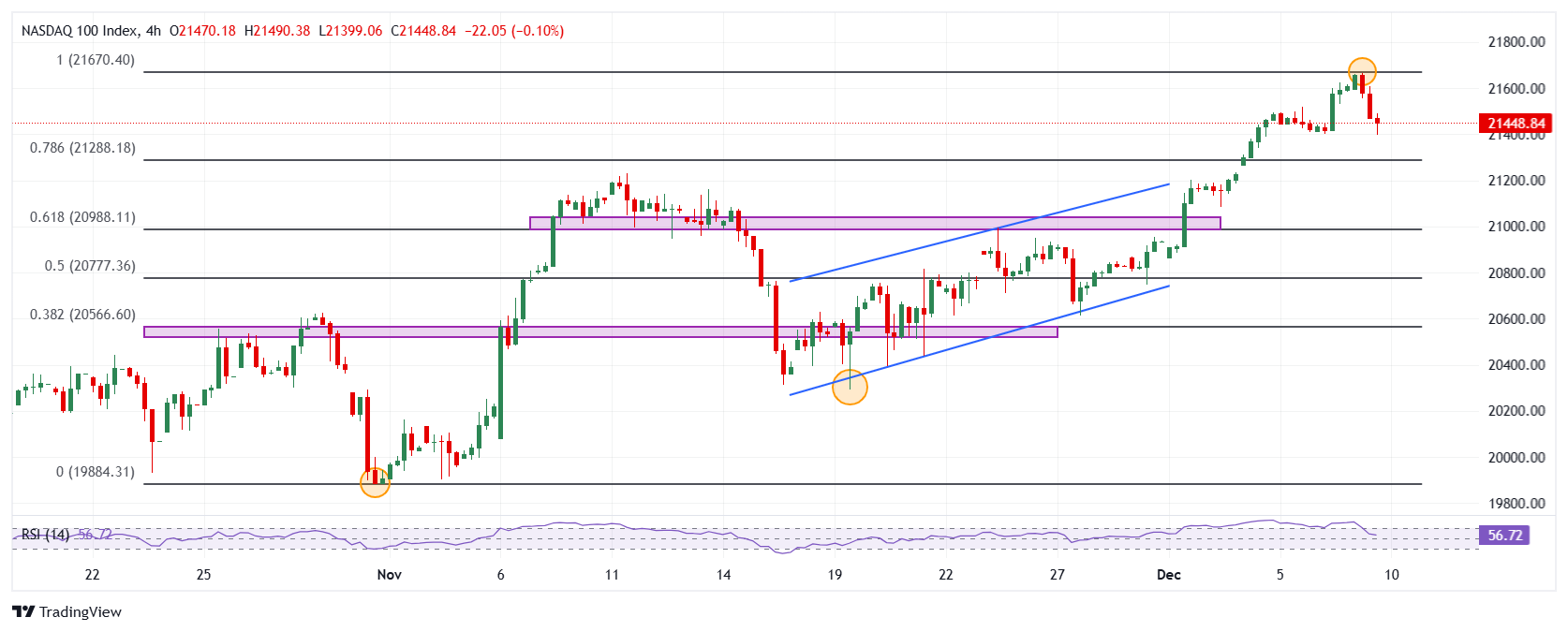- The Dow Jones falls 0.11% on the day.
- The Nasdaq 100 loses 0.64% daily.
- The S&P 500 falls 0.34% in Monday trading.
The Dow Jones gains 0.11%, currently trading at 44,587, prior to the publication of the United States Consumer Price Index.
The Dow Jones Industrial Average began trading at 44,555, while the Nasdaq 100 technology index opened at 21,594. The S&P 500 began the day at 6,080, reaching lows not seen since December 4 at 6,054.
The Dow Jones operates with losses dragged by Travelers and Nvidia
The Dow Jones Industrial Average is trading at 44.562 at the time of writing, losing 0.11%, reaching a November 26 low of 44.511.
Travelers (TRV) shares lose 2.92%, reaching lows not seen since November 8 at 253.00, marking their second consecutive session down. On the other hand, Nvidia (NVDA) shares fell 2.27%, reaching the lows of December 2 at 137.13.
Applovin Corporation and Comcast take the Nasdaq 100 into the negative zone
The Nasdaq 100 technology index fell 0.64% on Monday after reaching a new all-time high at 21,665, trading within the range of the Friday session.
Applovin Corporation (APP) shares plummet 14.21%, reaching lows not seen since December 3 at $332.35. In the same vein, Comcast (CMCSA) shares are sliding strongly, falling to the lows of September 18 at $38.78, losing 10.10% on Monday.
The S&P 500 is trading in negative territory in line with the main stock indices
The S&P 500 index falls 0.38% today, reaching the lows of December 4 at 6,054, pending the publication on Wednesday of the United States Consumer Price Index.
Market consensus expects US November year-on-year inflation to be 2.7%, slightly higher than the 2.6% reached in October.
Technical analysis of the Nasdaq 100
The Nasdaq 100 formed short-term resistance given by the all-time high reached today at 21,665. We see the closest support at 21,086, the minimum of December 3, close to the 61.8% Fibonacci retracement. The next key support is at 19,882, the October 31 pivot point.
Nasdaq 100 4-hour chart

The Dow Jones FAQs
The Dow Jones Industrial Average, one of the world’s oldest stock indices, is made up of the 30 most traded securities in the United States. The index is weighted by price rather than capitalization. It is calculated by adding the prices of the securities that comprise it and dividing them by a factor, currently 0.152. The index was founded by Charles Dow, also founder of the Wall Street Journal. In recent years it has been criticized for not being sufficiently representative, since it only follows 30 companies, unlike broader indices such as the S& P 500.
There are many factors that drive the Dow Jones Industrial Average (DJIA). The main one is the aggregate performance of its component companies, revealed in quarterly corporate earnings reports. US and global macroeconomic data also contribute, influencing investor sentiment. The level of interest rates, set by the Federal Reserve (Fed), also influences the DJIA, as it affects the cost of credit, on which many companies largely depend. Therefore, inflation can be a determining factor, as well as other parameters that influence the decisions of the Federal Reserve.
The Dow Theory is a method for identifying the main trend of the stock market developed by Charles Dow. A key step is to compare the direction of the Dow Jones Industrial Average (DJIA) and the Dow Jones Transportation Average (DJTA) and only follow trends where they are both moving in the same direction. Volume is a confirmation criterion. The theory uses elements of maximum and minimum analysis. The Dow theory proposes three phases of the trend: accumulation, when the smart money begins to buy or sell; public participation, when the general public joins the trend; and distribution, when the smart money abandons the trend.
There are several ways to trade the DJIA. One of them is to use ETFs that allow investors to trade the DJIA as a single security, instead of having to buy shares of the 30 companies that comprise it. A notable example is the SPDR Dow Jones Industrial Average ETF (DIA). Futures contracts on the DJIA allow traders to speculate on the future value of the index, and options provide the right, but not the obligation, to buy or sell the index at a predetermined price in the future. Mutual funds allow investors to purchase a portion of a diversified portfolio of DJIA securities, providing exposure to the global index.
Source: Fx Street
I am Joshua Winder, a senior-level journalist and editor at World Stock Market. I specialize in covering news related to the stock market and economic trends. With more than 8 years of experience in this field, I have become an expert in financial reporting.







